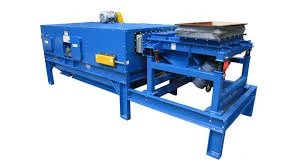

நவ் . 05, 2024 07:19 Back to list
The Principle of Hammer Mill
A hammer mill is a versatile and efficient machine used in various industries for size reduction and particle size control. Its design is uniquely effective for breaking down materials into smaller, manageable pieces, which is essential for numerous applications including agriculture, recycling, and food processing. Understanding the principle behind a hammer mill can help elucidate its widespread use and adaptability in different sectors.
The Principle of Hammer Mill
The basic structure of a hammer mill comprises a feed hopper, a rotor equipped with hammers, a sieve, and a discharge system. Initially, the material is fed into the hopper, where it is gravitationally dropped onto the rotating rotor. As the feed enters the chamber, it encounters the spinning hammers, which are designed to strike the material at high speeds. The hammers can vary in size, shape, and arrangement, allowing for customization depending on the material being processed.

The sieving action ensures that only particles that are smaller than the desired size exit the mill, while larger particles continue to be struck by the hammers until they reach the required size. This is particularly crucial in achieving uniform particle sizes, which can significantly affect the quality and behavior of the end product.
Additionally, the hammer mill features an adjustable screen size, providing flexibility in particle size control. By changing the screen or adjusting the speed of the rotor, operators can tailor the milling process to produce coarse or fine particles as needed. This adaptability makes hammer mills a preferred choice in operations where varying particle sizes are essential.
Moreover, the design of a hammer mill allows for easy maintenance and cleaning, ensuring minimal downtime in production. This is important in industries where contamination is a concern, such as in food processing. Regular maintenance of hammers and screens also prolongs the lifespan of the machine, making it a cost-effective investment.
In summary, the principle of a hammer mill revolves around impact mechanics, utilizing high-speed rotation of hammers to effectively reduce material size. Its versatility, efficiency, and ease of use make it an invaluable tool in various industries, contributing to increased productivity and better end-product quality. Understanding the underlying principles of this machine enhances our appreciation for its role in modern manufacturing and processing environments.
Latest news
Troubleshooting Common Eddy Separator Problems
NewsJul.04,2025
The Role of Metal Recycling Plants in Circular Economy
NewsJul.04,2025
The Impact of Recycling Line Pickers on Waste Management Costs
NewsJul.04,2025
Safety Features Every Metal Shredder Should Have
NewsJul.04,2025
How Industrial Shredders Improve Waste Management Systems
NewsJul.04,2025
How Cable Granulators Contribute to Sustainable Recycling
NewsJul.04,2025